Norwegian
Legion Military and Feldpost History
|
Freiwilligen
Legion Norwegen
In 1933, a Norwegian
pro-Nazi party was instituted by Vidkun Quisling and was called the "NASJONAL SAMLING" (National
Unity).
In April 1940, Germany invaded the Norwegian coastlines because Hitler feared that the
British fleet would invade Norway's vital strategic seaports and take control of its natural
iron resources. During the German occupation of Norway, the pro-Nazi Party under Quisling's
leadership actively supported the Germans.
There was a Norwegian interest in forming an
expeditionary force to fight along side the Finnish against the Soviets. With German support
represented by Reichskommissar Josef Terboven, the pro-nazi party called for a meeting of four
high officials of the Norwegian Army to create a legion. A massive recruiting rally was held on
the University Square in Oslo on 4 July 1941.
The Norwegian Government intended to form a full regiment of two battalions but due to strict
admissions standards and brief six terms of enlistment only one battalion was realized. They
were to be titled "Gula" and "Frosta" (later the named for the 1st battalion was changed to
VIKEN, the other battalion was never formed).
The Legion was sent to Bjolsen Skole camp in
Norway where uniforms were received. The Legionnaires were surprised to receive German SS
uniforms since they had expected to wear Norwegian or Finnish uniforms.

The only difference was the Norwegian National Flag sleeve patch worn on the SS uniforms. Members of the Nasjonal
Samling and its para-military arm "Hird" were allowed to wear their emblem, a circular St Olaf's
Cross with upright swords in silver and black as a sleeve patch. In addition a cuff title
bearing the Legion�s name was issued. A standard Legion collar patch (right collar only)
displaying a Norwegian lion holding an axed was used.
On 29 July 1941 the first 300 Norwegian
volunteers arrived in Kiel, Germany, and were sent to Fallingbostel Training Camp. By August
1941 the total number of recruits had grown to over 700. By the end of 1941, it had the strength
of 1218 men with an additional reserve battalion provided for replacement. The officers were
sent to Lauenburg training camp.
The Legion was officially named "Den Norske Legion" (The
Norwegian Legion). The Legion was commanded respectfully by Major Jorgen Bakke and Major
Finn Kjelstrup (both ex-Norwegian Officers) however both officers resigned in early December
1941. In December 1941, after completing six months enlistment, Legionnaires re-enlisted for
another six months. Originally the plan was to have them serve in the Finnish sector of the
Eastern Front but because of the critical situations elsewhere in Russia, the Legion was train to
the Leningrad Front.
This Legion had no contacts with their compatriots in the WIKING Division
who were considered full Waffen-SS cadre personnel. In February 1942, the Legion under the
Command of Sturmbannführer Arthur Quist was sent to the quietest sector near Leningrad front to
support the 2nd SS (motorized) Infantry-Brigade and 250th Spanish Blue Division. The 2nd SS
Brigade was an international unit, which included Dutch, Flemish and Latvians. In Norway the
recruitment continued unabated. In April 1942, the effective strength of the Legion amounted to
1150 men with another 150 on reserve.
By May 1942, the entire Legion, having taken almost half
in casualties over the previous three months, was relocated to Konstantinovka for refitting. In
July the losses combined with earlier casualties and six months enlistment caused a manpower
shortage in the Legion.
In August 1942, the Legion was reinforced with 200 new recruits, in
addition, another 93 men contingent arrived from the 1st Norwegian Police Company. By the end of
December 1942, the Legion's strength drop to 20 officers and 678 other ranks. On 1 March 1943,
the Legion including the 1st Police Company was withdrawn from the Front lines and sent to Norway
on home leave. In May 1943, about 600 veterans were sent to the Grafenwohr training camp in
Germany where the III SS Panzer Corps was being formed. Here in the Grafenwohr training camp,
the Legion was disbanded and the Norwegian volunteers were offered to re-enlist in the new "23.
SS Panzer-Grenadier Regiment Norge," (23rd SS Panzer-Grenadier Regiment Norway).
|
|
Norwegian
Postal History
Postal History:
In 1941, the Norwegian government made an agreement with Germany
that mail sent by Norwegian volunteers in the German forces had free Feldpost
services. Postal rates of 20Rpf was charged for packages sent from Germany
weighing 250gms to 1000gms, and 35Ore fee for those posted in Norway. Feldpost
mail from units with open addresses were required to add the "Portofreie
Dienstsache" notation, even when dispatching mail through Feldpost offices.
All mail was censored.
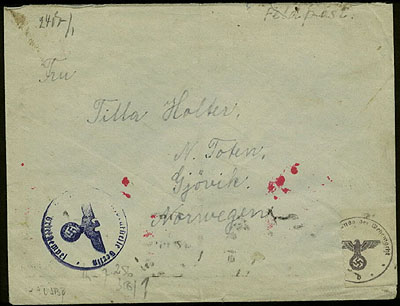
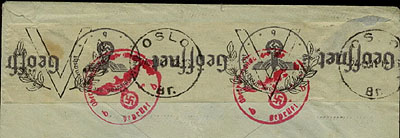
Norwegian
Feldpost
The
Feldpost cover shown above was mailed by a Norwegian who was in the Germania Rgt. of
the Wiking Division. Below shows a propaganda "Victory" postal cancel applied on
German censored sealing tape. In addition, notice the red censor hand stamping
also applied on the sealing tape.
Normally Norwegian volunteers who were enlisted in
Waffen-SS formations had their Feldpost mail inspected by SS examiners. SS mail
was examined and applied with circular "As" censor markings and/or sealing tapes.
Commercial or Feldpost mail was also inspected and examined in Norway or Germany
and bore the circular "Ao" (Oslo) or "Ab" (Berlin) markings. Because of the
lack of faith in the local post offices, in July 1942, a special postal service
was established to serve the civilian and military occupation authorities. This
service was the "Deutsche Dienstpost Norwegen," which remained in operation until
May 1945.
Censored control marks were applied in Norway for mail transferred from Feldpost
to civil post office. They were 15mm circular marks with the letters "FN"
(Feldpost Norwegen) and are found with numerals 1 through 5. They were used
between September 1942 till January 1944. A 16mm circular FN routing stamp was
used in northern Norway.

Norwegian Legion Feldpost
The
Feldpost cover shown above was mailed by a Norwegian Legion volunteer FPN 45086D (I Btl. 4th Co.). The reverse has army sealing tape with SS red circular censor marking. In addition, it has a Norwegian circular postal receipt cancel from Skien dated October 3, 1942.
|
|
Feldpost
numbers assigned to the Norwegian Legion
The Norwegian Legion (1941-1943) was assigned the following Feldpost numbers
for the Viken Battalion.
Reserve Staff-------------------------------44243
1st.
I Btl. Viken: Staff (1-4 Co.) --------------45086(A-D)
14th.
Anti-tank Co.------------------------- 45086E
War
Reporters Platoon------------------ 45084
Formation Group Mysen--------------- 45084
Replacement Btl. Staff (1-4 Co.)------ 47703
Cycle Btl.---------------------------------- 46524
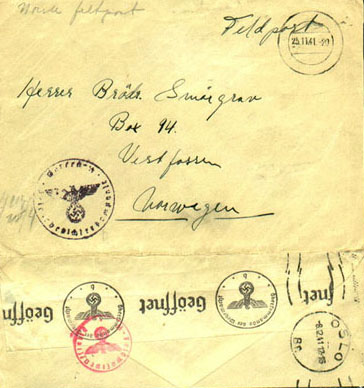
Norwegian Legion
Feldpost
Norwegian
Legion Feldpost
The
Norwegian Legion SS-Feldpost cover shown above was mailed by a Norwegian
War Correspondent.
|
|
SS Skijaeger
Battaillon Norge
During the
summer of 1941, the SS Norwegian Volunteer Ski Company with 120 men was formed in
Finland. In September 1942, this company was sent to the SS Training camp in
Sennheim, Alsace, in care of a Finnish SS-Hauptsturmführer. The NCOs and officers
went to various SS Training schools in Germany.
In February 1943, after intensive
infantry training, the ski company was sent by train to Danzig where it was joined
by the NCOs and officers. The company was placed under the command of
Obersturmführer Gust Jonassen, who was the founder of the ski company. The Ski
Company was sent to the Karelian area of northeastern Finland where it was attached
to the SS Reconnaissance Detachment 6, of the "6. SS Geb Div Nord" (6th SS Mountain
Division). The Ski Company served in Finland till July 1943. The volunteers were
sent on an extended home leave.
In October 1943, enough volunteers had joined to
form a new SS Norwegian Ski Battalion, composed of three companies. A Number of
volunteers transferred from the Nordland Division, who expressed a preference for
serving in Finland. The formation of the SS Norwegian Ski Battalion took place in
Oulu, Finland. The ski battalion was designated the "SS Skijaeger Battaillon Norge"
and was attached to the SS Reconnaissance Detachment 6 where it served in the
northeastern part of Finland.
In October 1943, an independent Norwegian Police
unit that was outfitted and managed by the Waffen-SS arrived in Finland for a six
month service.
Designated as the "2. Norwegen Polizei Kompanie" it was deployed
to guard the defensive perimeter located in Schapk-Osero just 10kms behind the Nord
Divisional front-line. In April 1944, the 2nd Police Company, which fought with
distinction was withdrawn from the front lines and sent back to Norway.
The
Norwegian Ski Battalion was depleted of needed personnel and as a consequence it
extended their defensive lines. By June 1944, the battalion had the strength of
300 men and in the course of continuous fighting it was depleted to half of its
manpower when it was confronted and overran by the Russian 731st Rifle Regiment.
After retreating through northern Finland and Norway, the depleted battalion was
sent to the training grounds at Mysen, Norway for refitting. In August 1944, the
ski battalion received 200 new recruits from Norway including 150 volunteers of
the 3rd Norwegian Police Company.
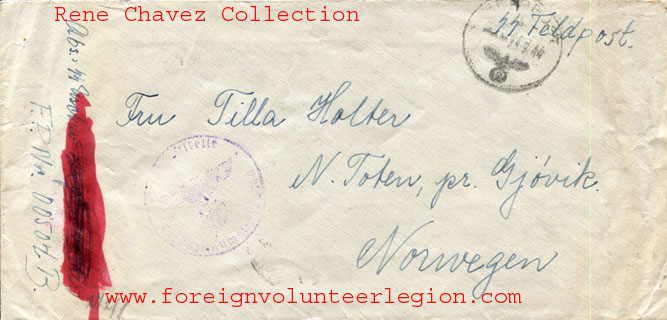
Rare SS Feldpost mailed on September 1944 by a Norwegian volunteer assigned to FPN 00504B
(SS Skijaeger Battaillon Norge). The senders name has been removed with black ink.
The reverse has army sealing tape and Oslo circular dated (October 20, 1944) roller cancel.
The new formation was referred as the "SS Polizie
Battaillon 506." The battalion was re-trained and refitted until the day of Finnish
capitulation on 4 September 1944. The Germans immediately began withdrawing
towards northern Norway. The ski battalion had to cover and protect the pulled
back of the Nord Division. By November 1944, it retreated from the Lappland area
and into Norway, where it disintegrated in January 1945.
A 4th Norwegian Police Company was formed late in the war, it did not participate
on the Eastern Front. In addition SS guard battalion was recruited in 1942 to
guard Russian prisoners of war in Norway. Norwegian volunteers had joined the
Luftwaffe service since early 1943.
It is estimated that some 50,000 Norwegians served in the German Wehrmacht,
Waffen-SS and para-military formations in WWII. Norwegians served throughout the
war in with other Waffen-SS units. In late 1940, Waffen-SS recruiting stations
were set up in all the principal Norwegian towns. On 20 April 1940, the Germans
announced the formation of the Nordland Regiment. This SS regiment was composed of Legionnaires from Denmark and Norway.
In April 1941, 294 Norwegian and 216 Danish volunteers were fitted into the "SS Nordland Regiment."
By June 1941, it had 25 Officers and 1509 other ranks, 510 of which were Norwegians and Danes. The Nordland Regiment and the "Westland Regiment," which was composed of Dutch and Flemish volunteers were grouped with the exclusive SS German volunteer formation
"Germania Regiment."
In 1941, these three regiments were incorporated into a newly formed SS panzer division, designated the "5. SS Panzer-Grenadier Division Wiking."
In November 1942, the SS Nordland Rgt. was refitted and re-designated as the SS Grenadier Rgt. Norge.
In March 1943, SS Gren. Rgt. Norge was withdrawn to form nucleus for the new SS
Division Nordland. Norwegian veterans on home leave had the option to re-join
the division.
|
|
Feldpost
number assigned to the SS Skijaeger Battaillon Norge & SS 2.Norwegen Polizei Kp
SS
Skijaeger Btl----------------------------------- 00504
SS 2.Norwegen Polizei Kp-----------------------02148
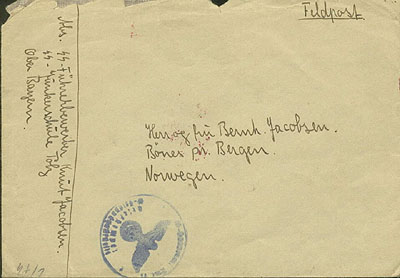
Norwegian
Waffen-SS Feldpost
Norwegian
SS-Feldpost
The
SS-Feldpost cover shown above was mailed by a Norwegian who
was in training in the SS-Junkerschule Tolz.
[ Front
Page ] [ Top] [Previous
Page [ Next Page]
|
|






